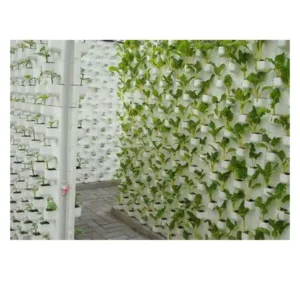Hydroponic systems in a greenhouse can be integrated with various environmental control systems to create an optimal growing environment for plants. The integration enhances overall efficiency, productivity, and resource utilization.
Here’s how hydroponic systems commonly integrate with other environmental control systems:
- Climate Control Systems:
- Temperature and Humidity Control: Hydroponic systems often integrate with climate control systems to manage temperature and humidity levels. This includes heating, ventilation, and cooling systems that help maintain the ideal climate for plant growth.
- Ventilation Systems:
- Air Exchange and CO2 Enrichment: Proper ventilation is essential in hydroponic systems to regulate temperature and humidity. Ventilation systems ensure adequate air exchange and can also be integrated with CO2 enrichment systems to optimize photosynthesis.
- Lighting Systems:
- Supplemental Lighting: In greenhouses with hydroponic systems, supplemental lighting is often integrated to provide additional light during periods of low natural sunlight. This can include high-efficiency artificial lighting systems like LEDs that support plant growth in the absence of sunlight.
- Automated Control Systems:
- Sensors and Controllers: Automated control systems with sensors are used to monitor various environmental parameters such as temperature, humidity, nutrient levels, and pH in hydroponic systems. Controllers adjust these parameters automatically to maintain optimal growing conditions.
- Irrigation Systems:
- Precision Irrigation: Hydroponic systems are often integrated with precision irrigation systems. These systems deliver nutrient-rich water directly to the plant roots, ensuring efficient nutrient absorption and minimizing water wastage.
- Nutrient Delivery Systems:
- Automated Nutrient Management: Hydroponic systems require precise nutrient delivery. Automated nutrient delivery systems are integrated to regulate nutrient concentrations in the water, adjusting the nutrient solution based on plant growth stages and environmental conditions.
- pH and EC Monitoring:
- Automated pH and EC Adjustment: pH and electrical conductivity (EC) levels are critical in hydroponic systems. Automated systems monitor and adjust pH and EC levels in the nutrient solution, ensuring that the growing medium remains within the optimal range for plant uptake.
- Fertigation Systems:
- Integrated Fertilization and Irrigation: Fertigation systems combine the processes of fertilization and irrigation. China Hydroponic System suppliers This integration allows for precise control over nutrient delivery, ensuring that plants receive the right balance of essential elements.
- Monitoring and Data Logging:
- Data-Driven Decision-Making: Integrated monitoring and data logging systems collect data from various sensors in the hydroponic system. This data is analyzed to make informed decisions regarding environmental adjustments, leading to improved crop management.
- CO2 Enrichment Systems:
- Optimizing Photosynthesis: Hydroponic systems can benefit from CO2 enrichment to enhance photosynthesis. Integration with CO2 systems ensures that elevated CO2 levels are maintained during daylight hours, promoting increased plant growth.
- Shading Systems:
- Light Management: Greenhouses with hydroponic systems often integrate shading systems to manage light levels. These systems help prevent excessive light exposure, reducing the risk of photoinhibition and heat stress.
- Integrated Pest Management (IPM):
- Pest and Disease Control: Hydroponic systems can be integrated with IPM strategies. This includes the use of biological controls, beneficial insects, and other measures to manage pests and diseases in an environmentally friendly manner.
- Energy Management Systems:
- Optimizing Energy Use: Greenhouses with hydroponic systems may integrate energy management systems to optimize the use of heating, cooling, and lighting systems. This integration helps improve energy efficiency and reduce operational costs.
The integration of hydroponic systems with various environmental control systems is part of a comprehensive approach to precision agriculture. By combining these technologies, growers can create a controlled and efficient environment that maximizes plant growth, yield, and resource utilization while minimizing environmental impact.
